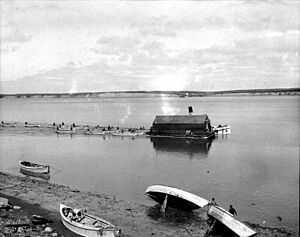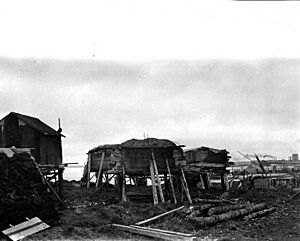Naknek, Alaska facts for kids
Quick facts for kids
Naknek
Nakniq
|
|
|---|---|

A westward view of downtown Naknek in the spring
|
|

Location of Naknek, Alaska
|
|
| Country | United States |
| State | Alaska |
| Borough | Bristol Bay |
| Area | |
| • Total | 82.20 sq mi (212.90 km2) |
| • Land | 81.54 sq mi (211.18 km2) |
| • Water | 0.67 sq mi (1.72 km2) |
| Population
(2020)
|
|
| • Total | 470 |
| • Density | 5.76/sq mi (2.23/km2) |
| Time zone | UTC-9 (Alaska (AKST)) |
| • Summer (DST) | UTC-8 (AKDT) |
| ZIP code |
99633
|
| Area code(s) | 907 |
| FIPS code | 02-52060 |
Naknek (which is Nakniq in the Yup'ik language) is a small community in Alaska, USA. It is known as a census-designated place, which means it's a specific area identified by the U.S. Census Bureau for statistical purposes. Naknek is also the main town, or borough seat, of Bristol Bay Borough.
In 2020, about 470 people lived in Naknek. This number was a bit lower than in 2010, when 544 people lived there. The town is located on the north side of the Naknek River. This river flows into Kvichak Bay, which is part of the larger Bristol Bay. Right across the river from Naknek is another community called South Naknek.
Contents
Where is Naknek Located?
Naknek is found at a specific spot on the map: 58 degrees, 44 minutes, 23 seconds North latitude and 156 degrees, 58 minutes, 18 seconds West longitude.
The total area of Naknek is about 82.20 square miles (212.90 square kilometers). Most of this area is land, about 81.54 square miles (211.18 square kilometers). A small part, about 0.67 square miles (1.72 square kilometers), is water.
A Brief History of Naknek
The first reports of an Eskimo village here came from Captain Mikhail Vasilyev of the Russian Navy around 1821. He called the village "Naugiek." Later, in 1826, Lieutenant Gavril Sarichev listed it as "Naugvik." Finally, Captain Mikhail Tebenkov spelled it "Naknek" in 1852, which is the name we use today.
A fort called Surarov or "Sowaroff" was built nearby, possibly in the same spot. The Naknek post office, where people could send and receive mail, was officially opened in 1907.
How Has Naknek's Population Changed?
| Historical population | |||
|---|---|---|---|
| Census | Pop. | %± | |
| 1880 | 192 | — | |
| 1890 | 51 | −73.4% | |
| 1900 | 431 | 745.1% | |
| 1920 | 111 | — | |
| 1930 | 173 | 55.9% | |
| 1940 | 152 | −12.1% | |
| 1950 | 174 | 14.5% | |
| 1960 | 249 | 43.1% | |
| 1970 | 318 | 27.7% | |
| 1980 | 318 | 0.0% | |
| 1990 | 575 | 80.8% | |
| 2000 | 678 | 17.9% | |
| 2010 | 544 | −19.8% | |
| 2020 | 470 | −13.6% | |
| U.S. Decennial Census | |||
Naknek first appeared in the U.S. Census in 1880. Back then, it was listed as one of two Inuit villages called "Paugwik." This name might have also included the area that is now South Naknek.
Over the years, the population of Naknek has changed quite a bit. For example, in 1900, there were 431 people, but by 1920, it had dropped to 111. The population grew steadily from the 1950s to 2000, reaching its highest point of 678 people. Since then, the population has decreased slightly.
In 2000, there were 678 people living in Naknek. About 45% of the people identified as Native American, and nearly 50% identified as White. A small number of people were Black, Asian, or Pacific Islander, or from two or more races.
Many households in Naknek had children under 18 living with them. The average household had about 2.74 people.
Education in Naknek
Naknek is part of the Bristol Bay Borough School District. Both Naknek Elementary School and Bristol Bay Middle/High School are located in the same building. Together, these schools serve about 100 students from the community.
Famous People from Naknek
- Adelheid Herrmann: She was a politician who served as an Alaskan state legislator from 1983 to 1989. A state legislator helps make laws for the state.
- Jay Hammond: He was a very important person in Alaska's history, serving as the state's governor. A governor is the leader of a state government.
See also
 In Spanish: Naknek para niños
In Spanish: Naknek para niños




